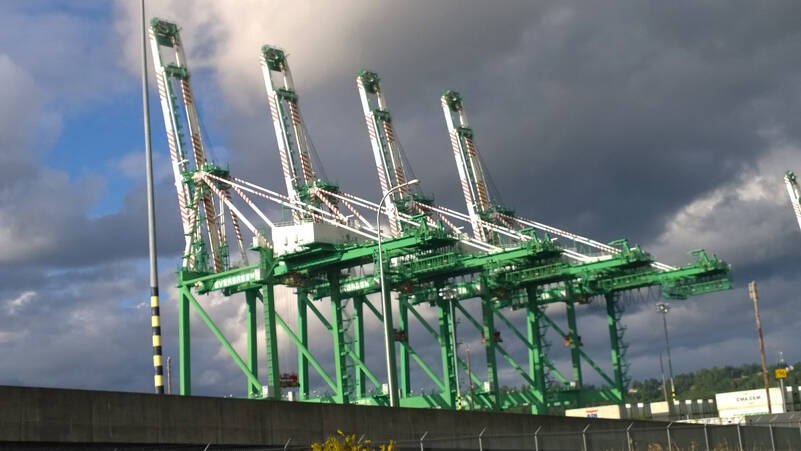SEATTLE + TACOMA —The ports of Seattle, Tacoma, and the combined container operations of The Northwest Seaport Alliance (NWSA) have adopted near-term implementation plans that guide emission reduction efforts for seaport-related activities. The Northwest Ports Clean Air Strategy covers six sectors of port activity: oceangoing vessels, cargo-handling equipment, trucks, harbor vessels, rail, and port administration and tenant facilities. The recently adopted implementation plans direct changes in equipment, fuels, and infrastructure to fulfil the ports’ voluntary commitment to the Clean Air Strategy’s vision of phasing out seaport-related emissions by 2050 to support cleaner air for local communities.
The Port of Seattle adopted the Charting the Course to Zero: Port of Seattle’s Maritime Climate and Air Action Plan on November 16. The Action plan identifies strategies through 2030 to halve greenhouse gas emissions, including commitments to:
* Complete the Seattle Waterfront Clean Energy Strategy to plan for the transition to zero-emissions equipment, locomotives, vehicles, vessels, and buildings along the waterfront
* Install shore power infrastructure at all cruise ship berths and achieve a 100% connection rate for homeport cruise ship calls
* Phase out fossil natural gas in Port-owned buildings and transition all Port-owned light-duty fleet vehicles to electric or renewable fuels
“Each of our ports plans were developed in close collaboration with government, industry, and community stakeholders whose engagement strengthened and increased the viability of the Ports’ commitments.” said Fred Felleman, Port of Seattle Commission President and Co-Chair of The Northwest Seaport Alliance. “We are starting today so that we can meet our carbon reduction commitments for decades to come and will continue to seek state, federal and private resources to increase our competitiveness as a green gateway.”
The Port of Tacoma adopted their Clean Air Strategy Implementation Plan on November 17. The plan includes:
* Developing and implementing a policy to incorporate sustainable building practices in new Port-owned buildings and major remodel projects.
* Installing electric vehicle charging stations at five Port locations
* Transitioning the Port’s fleet to plug-in hybrid or electric vehicles
“The adoption of these implementation plans is a critical step in the success of the Northwest Ports Clean Air Strategy and maintaining our commitment to reducing air emissions to zero,” stated Dick Marzano, Port of Tacoma Commission President and Co-Chair of The Northwest Seaport Alliance. “Over the next five years, our ports will enact these changes and make key investments that enable us to protect air quality and continue to be leaders in the international call to take action on climate change.”
The Managing Members of the NWSA adopted their 2021-2025 Implementation Plan on December 7. The NWSA plan includes:
* Reducing emissions from existing fleets of vessels, vehicles, and equipment by scrapping more than 50 high-polluting trucks through the Scrap and Replace Program, adding zero emissions cargo handling equipment to operations, and deploying a hybrid or zero-emission tug within the gateway. This is in addition to the 450 trucks that have already been scrapped using grant funding from the Environmental Protection Agency (EPA), WA Department of Ecology, City of Seattle, Puget Sound Clean Air Agency, and the Department of Transportation.
* Accelerating the transition to zero-emission fuels and technologies through the development of fueling and charging infrastructure including continued installation of shore power on international container terminals. One terminal has already been equipped with shore power, construction of shore power systems at two more terminals has been committed, and planning and design is beginning on shore power systems for four additional terminals.
* Collaborating closely with tenants and industry partners to deploy the Clean Truck Collaborative and implement an International Engagement Strategy for reducing vessel emissions.
The Clean Air Strategy and port-specific implementation plans were developed with extensive engagement across industry, government, non-profits, and near-port communities. The Northwest Ports will continue to collaborate with their stakeholders, other ports and partners to advance toward a zero-emissions future, in addition to advancing an international engagement strategy for reducing vessel emissions. Northwest ports are also working with shippers and cruise operators to help them meet their own carbon reduction goals.
The Northwest Ports look forward to continuing this collaboration and with other ports and partners to lead a just, fair and equitable transition to a zero-emissions maritime future.
About the Northwest Ports Clean Air Strategy
The Northwest Ports Clean Air Strategy (Strategy) is a collaborative effort between the Port of Seattle, Port of Tacoma, Northwest Seaport Alliance, and Vancouver Fraser Port Authority in British Columbia (Northwest Ports) to reduce air and greenhouse gas (GHG) emissions from shipping and port operations in the ports’ shared airshed.
First adopted in 2008, the Strategy was the first of its kind in the Port community. The Strategy seeks to encourage environmental action above competition and created a means for the four Northwest Ports to work collectively and voluntarily to reduce emissions. The 2020 Strategy sets a new vision to phase out emissions from seaport-related activities by 2050, supporting cleaner air for our local communities and fulfilling our shared responsibility to help limit global temperature rise to 1.5°C.
– Port of Tacoma






